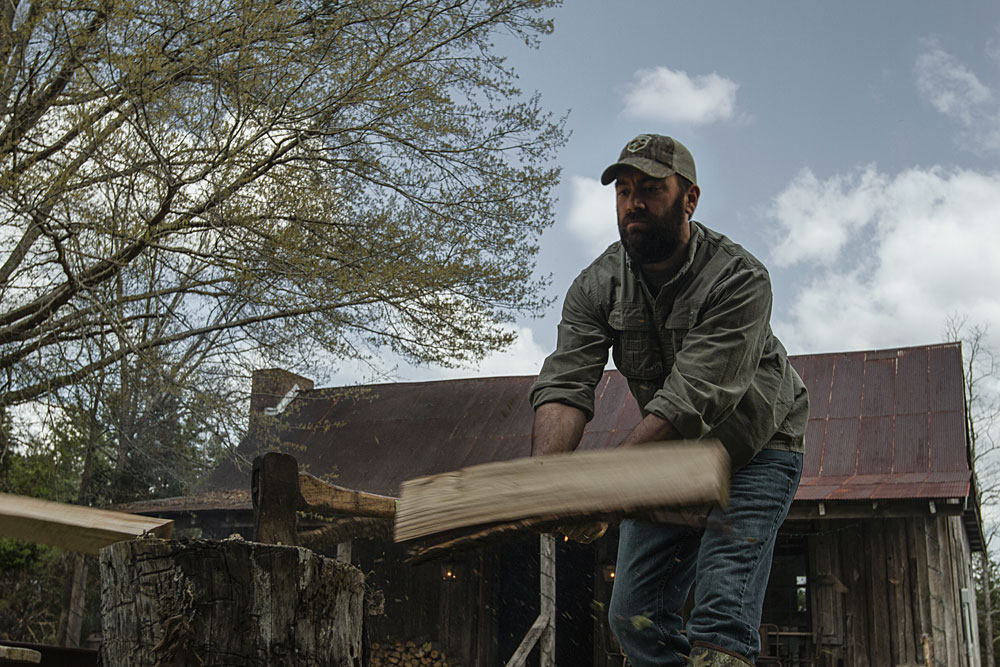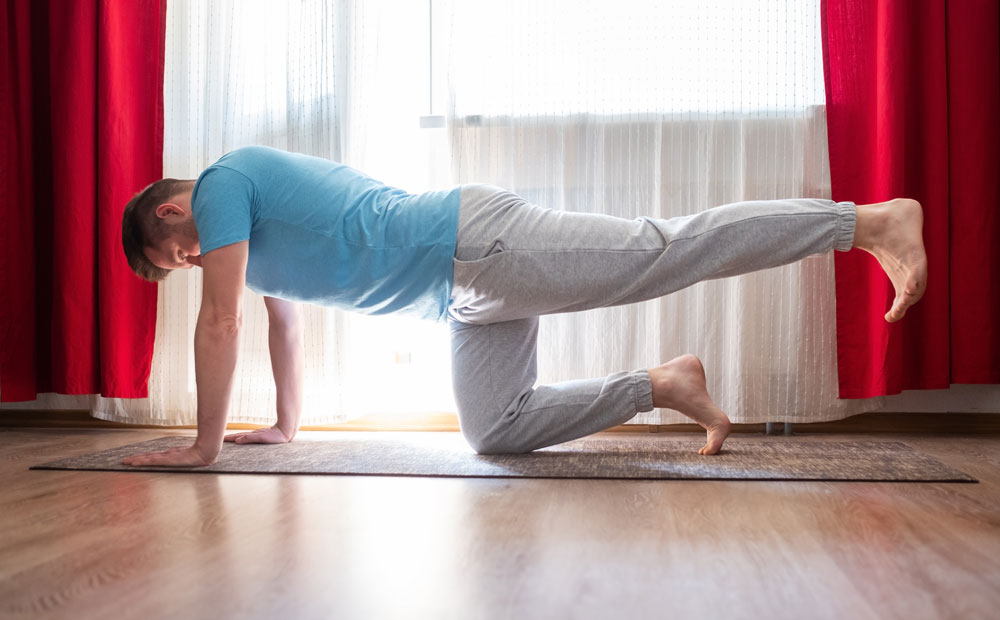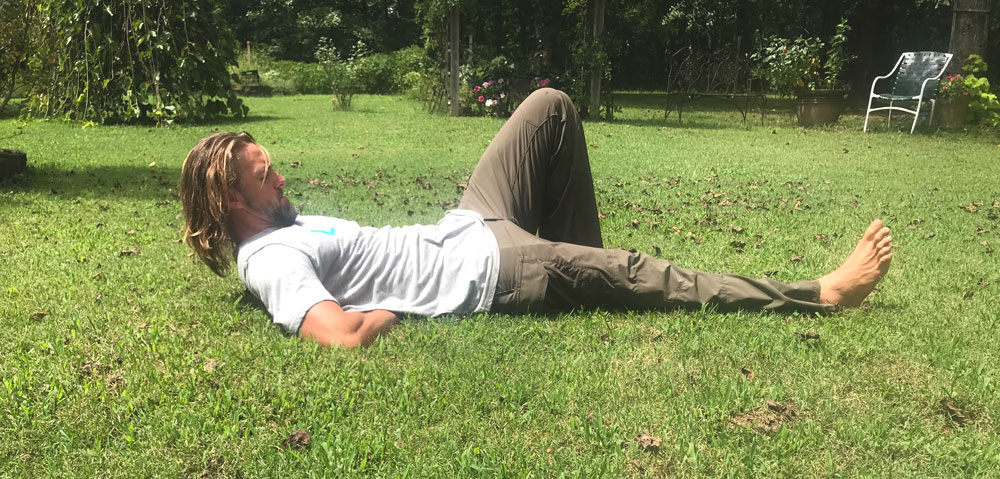Brooks Tiller
Dr. Brooks Tiller is an American Ninja Warrior competitor, adventure athlete, speaker and author. He has traveled the globe as a physical therapist, strength coach and movement specialist; coaching Olympic and professional athletes to increase their performance physically and mentally. Tiller lives in Tennessee with his wife and two children.

Back pain is a leading factor of missed days on the job and probably a major reason for missed days of hunting.
Most often it is not our backs that are the culprit, but a weak core leading to an unstable spinal column. This instability creates many problems that can all be summed up as back pain. Sometimes it is as minor as a light strain while at other times it can involve nerves creating pain or even numbness in the extremities.
Backs don’t just “go out.” While it may seem that one action or movement may have caused the injury, most often it is a result of cumulative factors that add up to cause the injury. But good news, we can combat the injuries and be prepared to tackle the obstacles that we will encounter in the wilderness.
A strong, resilient core is not about looking good on the beach. Our core is more than the airbrushed six-pack abs plastered on a magazine cover. Our core is the pillar that ensures that we move properly. More specifically, it ensures that our spine is protected and functions well. Strengthening our core helps to, ultimately, eliminate lower back pain and disorders so that we are able to complete our normal daily activities without pain or movement deficiency.
All too often, I have heard folks say they were going to rest their sore painful back. While a good night's rest may help with some soreness, rest rarely fixes it. Think if your truck broke down, would just letting it sit there fix it or would you need to do a little work on it?
Lying in bed can actually be detrimental. Inactivity leads to a loss of muscle mass and therefore even more spinal instability. In addition, the disc located between the vertebrae that serve as shock absorbers and create room for nerves to exit the spinal column can lose their elasticity. The discs are similar to a sponge. They absorb water when supine and unweighted but will let water out when squeezed as we are upright. Lying for too long especially in a flexed position increases the absorption of fluid, causing the disc to increase in size, which can cause pain, pressure, and even compromise the spinal nerves that control our extremities.
While we lie in bed, our disc soaks up fluid like a sponge. This is good to a point as the intake also allows an influx of nutrition. But, too much fluid in with nothing going out can cause the disc to become stiff. When we get out of bed and begin to move around, just like the sponge with a little squeeze, the disc will let some fluid out gradually throughout the day. This also pushes out trash so that the body can heal itself.
One of the most important things we can do to decrease back pain and improve our mobility is to move. Think of the mornings after a long hard day. Rolling out of bed feels stiff and sore but seems to loosen up after getting up and walking around. Walking serves multiple key purposes when it comes to the health of our back and spine.
As we walk, the disc goes through a pumping motion as they move and adjust between the vertebrae. This brings in healthy nutritious blood while pumping out waste to speed up recovery. With every step, muscles in the back are contracting and relaxing to help us move while stabilizing our body. Movement also promotes blood flow throughout the body, which increases blood flow and recovery. And finally, movement is medicine. For not only the body but also the mind. Simply moving helps us to breathe deeper and releases endorphins that help us to feel better.
Let's Get To Work
There are a multitude of exercises that can improve our core strength and stability. But in order to get the most bang for our buck, there are three key exercises that I have utilized with patients and clients to decrease and prevent back pain. These exercises have been studied in the lab as well as tested in real life settings to be the best and most effective to improve core stability, decrease risk of back injury, and eliminate back pain.
Spinal Stability
Our body is a linked system. The same way that our truck requires several systems to run, our body is a combination of systems that work together. While it may seem that some exercises focus on one specific body part, most movements require more than meets the eye.
When we walk, our arms move to help us keep balance while our core muscles contract and relax to help keep our bodies stable and have us moving forward. To improve our core strength and stability and decrease back pain there are three key exercises we can do on a daily basis. They are the bird dog, a side plank, and the McGill curl up. First, we will cover the bird dog and side plank exercises and then finally dive deep into the specifics of the McGill curl up.
The core often brings up images and thoughts of glistening six-pack abs on the beach, but for a stable and healthy core, it is much more than a showy six-pack. Improving strength and endurance of the muscles that make up the sides of the core are vital. Picture the core as a box with the beach abs on the front and the spinal musculature of the back, the sides consist of several groups of muscles that make the box complete and strong.
Bird Dog

The bird dog exercise gets its name because it looks like a bird dog in full point. It will challenge the body as it works on a reciprocal movement pattern, meaning that opposite arms and legs move simultaneously. This is similar to walking but performed in a controlled manner in a stable base of support from all fours. The bird dog helps to improve our stability by increasing the strength and endurance of our posterior chain. This includes the low back, the glutes, as well as some of the front and side musculature of our core.
To complete the bird dog, begin in a tabletop position with our arms straight and hands directly below the shoulders. The hips and knees both bent to about a 90-degree angle with the knees directly under the hips. Place a towel under the knees to decrease pressure against the floor. Finally, with the lower leg and feet in line with the body rest the toes on the floor comfortably.
From this position, to get a good feel for the movement, we will begin with moving one limb at a time. Start by reaching forward with the right arm bringing it in line with the body. Return the right arm back to the beginning position and repeat reaching with the left arm. Next, extend the right leg straight behind the body thinking of pushing the heel to the wall. This will create a plumb line through the body from the ear to the heel. Return the right leg to the beginning position and repeat with the left leg.
Once we have mastered the individual movements it is time to combine them to increase difficulty and performance. From the tabletop position on all fours, begin moving slowly and controlled by reaching forward with the right arm while extending back with the left leg. Viewing from the side, a plumb line should run from fingertips through our torso down our leg to the heel. Keep the core tight and spine solid. Resist allowing the body to rotate and be aware not to allow the mid-section and spine to slouch or slump. Slowly come back to the starting position and allow a moment to reset. Then repeat the movement with the opposite sides.
As our core and posterior chain get better with improved strength and endurance, we will be able to hold the bird dog position longer. In the beginning, aim for 8 reps with a 3-5 second hold on each side. Gradually increase to 10-second holds before increasing reps and adding additional rounds. One great way to improve strength and stamina is to perform one round in the morning and then another round in the evening. These can be performed as a warm-up to a workout or even for a break during the day.
Side Plank
A side plank is a great way to increase core strength and endurance. This exercise will help us move better, decrease back pain, and prevent back pain from raising its ugly head. To complete a side plank, we begin by lying on our right side and placing the right elbow on the floor. The shoulder should be directly above the elbow with the elbow bent to place the forearm flat on the floor. With our upper body stacked on its side, a plumb line can be drawn from the bottom elbow through the opposite shoulder.
To begin, while lying on our side, bend the knees 90 degrees and raise the hips up off the floor. The body should now be straight from the head to the knees. Hold this position for five to ten seconds before resting. Next, turn onto the left side to test the opposite side.
Once we are able to complete 10 reps with a 10-second hold on each side with our knees bent, we can take it to the next level by performing a side plank with our legs straight. This will increase the challenge on our body by increasing the lever arm. Repeat the same preparation as before, but this time we have our legs fully extended out straight. As we raise our hips off the ground, our body will form a straight line from the top of our head through our body to our feet. Begin by holding for five seconds and work up to a 10-second hold for 10 reps on each side. This will improve our strength and increase the endurance of our core musculature to ensure our back moves well and protect us from injury.
To take the side plank to an advanced level, slowly raise and lower the top leg 4-6 inches while maintaining proper body alignment. The added movement will challenge us and lead to greater strength and endurance as we head out into the wilderness.
McGill Curl Up

Look at most headlines or magazine covers and it may seem that situps or abdominal crunches are the magical ticket to a great core. But many of these exercises can actually be detrimental to our low back health. Exercises like these work more on our hip flexors and in turn increase our risk of back injury. The increase of our sedentary lifestyle today has many of us sitting for hours without moving. This prolonged immobility can lead to shortened and stiff hip flexors which can pull and put extra pressure on our low back. Traditional situps and crunches often do more harm than good as they overwork our already compromised hip flexors to shorten and tighten them while adding an excess burden and strain to our back.
The hip flexors are the key muscles that help us to lift our legs up as we walk and step over logs. These muscles attach to our low back. As these muscles become shortened, they pull on our low backs creating excess strain. These muscles often need to be stretched more than they need to be worked out. A simple couch stretch or lunge with overhead reach can improve our mobility and help us decrease back pain.
The McGill curl up was created and named after renowned biomechanical researcher Dr. Stuart McGill. Dr. McGill is a leader in the form, function, and injury prevention of the spine, through his personal experience working with numerous clients with back pain along with experiencing back pain.
The real beauty in the McGill curl up is that it can be completed even if we are debilitated by back pain and unable to move. This movement does not require any movement of the lumbar spine. So even if we find ourselves laid out flat with low back pain, there is something we can do to get the ball rolling to get better. Find a firm surface and lie down to begin the McGill curl up.
- Lying on your back, bend one knee and place a foot on the floor.
- The opposite leg should lie flat on the floor. If you have a leg with radiating pain, begin with the painful leg flat on the floor first.
- Next, place your hands or a small towel roll under your low back to help you maintain a comfortable neutral spine. A neutral spine is not a straight line but actually has some natural arches and curves.
- Slightly tuck your chin to maintain a neutral spine.
- Lightly lift your head and shoulders slightly. The shoulders should only come off the floor a few inches. The curl up should not involve any movement of the low spine. If you feel any pain or tingling radiating down the leg or if low back pain increases, it is most likely due to flexion of the lumbar spine. Rest and reset. Once you have reset, attempt again while focusing on form without movement of the low back.
- Hold this light curl up with the head and shoulders slightly unweighted for five to ten seconds. Holding this position will create an engaged core.
- Relax and return to the starting position. Perform five reps with each side before alternating leg position.
Performing this exercise in a descending pyramid will improve stability and help to decrease low back pain. Begin with five reps with an 8-10 second hold on each side. Then for the next round, perform 3 reps holding for 8-10 seconds. Then for the final round, complete one rep with an 8 to 10-second hold. Rest 30-60 seconds between each round. This set can be completed 2-3 times a day as needed.
The descending pyramid takes into account fatigue that accrues as we do any activity. As strength and stability improves, the 5-3-1 descending pyramid will become easier. Adding in an extra round with more reps helps us to improve and fight off pain and injury. Add in 7 reps at the beginning to make a descending pyramid of 7-5-3-1 while continuing to maintain a 10-second hold of each rep.
Back pain is one of our biggest adversaries in life. Back pain is the main reason for missed days of work and worse probably one of the main reasons we miss days or even entire hunting seasons. Adding the McGill curl up along with bird dogs and side planks into our daily regimen will ensure that our backs are strong and stable. Improved strength, mobility, endurance, and stability will have us ready to overcome the obstacles and face any challenges that we may face in the wilderness.






























